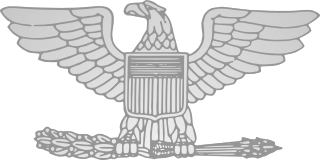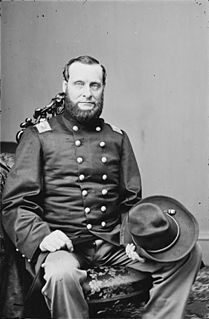Service
The 4th Kentucky Infantry was organized at Camp Dick Robinson and mustered in for a three-year enlistment on October 9, 1861, under the command of Colonel Speed Smith Fry. In February 1864, the regiment was reorganized at Lexington, Kentucky, as the 4th Regiment Kentucky Mounted Infantry.

In mid-May 1861, U. S. Navy lieutenant William "Bull" Nelson armed Kentuckians loyal to the Union and that soon became the foundation for his receiving authority to enlist 10,000 troops for a campaign into East Tennessee. On August 6, 1861, those recruits marched into Camp Dick Robinson, making it the first Federal base south of the Ohio River. For Col. George C. Kniffen, "the wisdom of President Lincoln commissioning. .. Nelson to organize a military force on the [neutral] soil of Kentucky" prevented making the state a "battle ground for many months" and it thereby changed the whole direction of the war. In 1864, Salmon P. Chase declared in a speech at Louisville "when Kentucky faltered, hesitated" in the early stages of the Civil War, that undecided "status was settled by WILLIAM NELSON, at Camp Dick Robinson." Six years later, Indiana Senator Daniel D. Pratt reported to the U. S. Senate that Camp Dick Robinson "was one of the most noted military encampments of the war.. .. From its admirable locality and advantages, it was almost indispensable for the successful operations of the" Civil War.

In the United States Army, Marine Corps, and Air Force, colonel is the most senior field grade military officer rank, immediately above the rank of lieutenant colonel and immediately below the rank of brigadier general. It is equivalent to the naval rank of captain in the other uniformed services. The pay grade for colonel is O-6.

Lexington, consolidated with Fayette County and often denoted as Lexington-Fayette, is the second-largest city in Kentucky and the 60th-largest city in the United States. By land area, Lexington is the 28th largest city in the United States. Known as the "Horse Capital of the World," it is the heart of the state's Bluegrass region. It has a nonpartisan mayor-council form of government, with 12 council districts and three members elected at large, with the highest vote-getter designated vice mayor. In the 2017 U.S. Census Estimate, the city's population was 321,959, anchoring a metropolitan area of 512,650 people and a combined statistical area of 856,849 people.
The regiment was attached to Thomas' Command, Army of the Ohio, to November 1861. 2nd Brigade, Army of the Ohio, to December 1861. 2nd Brigade, 1st Division, Army of the Ohio, to September 1862. 2nd Brigade, 1st Division, III Corps, Army of the Ohio, to November 1862. 2nd Brigade, 3rd Division, Center, XIV Corps, Army of the Cumberland, to January 1863. 2nd Brigade, 3rd Division, XIV Corps, to October 1863. 3rd Brigade, 3rd Division, XIV Corps, to June 1864. 1st Brigade, 1st Division, Cavalry Corps, Army of the Cumberland, to November 1864. 1st Brigade, 1st Division, Cavalry Corps, Military Division of Mississippi, to August 1865.
The Army of the Ohio was the name of two Union armies in the American Civil War. The first army became the Army of the Cumberland and the second army was created in 1863.

There were four formations in the Union Army designated as III Corps during the American Civil War.

XIV Corps was a corps of the Union Army during the American Civil War. It was one of the earliest corps formations in the Western Theater of the American Civil War.
The 4th Kentucky Infantry mustered out of service at Macon, Georgia, on August 17, 1865.

Macon, officially Macon–Bibb County, is a consolidated city-county located in the state of Georgia, United States. Macon lies near the geographic center of the state, approximately 85 miles (137 km) south of Atlanta, hence the city's nickname "The Heart of Georgia."
Detailed service
Moved to Crab Orchard, Ky., October 28, 1861, thence to Lebanon, Ky., and duty there until January 1862. Advance on Camp Hamilton January 1–15. Action at Logan's Cross Roads on Fishing Creek January 19. Battle of Mill Springs January 19–20. Duty at Mill Springs until February 11. Moved to Louisville, Ky., thence to Nashville, Tenn., February 11-March 2. March to Savannah, Tenn., March 20-April 7. Expedition to Bear Creek, Ala., April 12–13. Advance on and siege of Corinth, Miss., April 29-May 30. Buell's Campaign in northern Alabama and middle Tennessee June to August. Action at Decatur August 7. March to Nashville, Tenn., thence to Louisville, Ky., in pursuit of Bragg August 20-September 26. Pursuit of Bragg into Kentucky October 1–16. Battle of Perryville October 8. March to Gallatin, Tenn., and duty there until January 13, 1863. Operations against Morgan December 22, 1862 – January 2, 1863. Action at Boston December 29, 1862. Moved to Nashville, Tenn., January 13, 1863, and duty there until June. Expedition toward Columbia March 4–14. Tullahoma Campaign June 24-July 7. Hoover's Gap June 24–26. Tullahoma June 29–30. Elk River July 3. Occupation of middle Tennessee until August 16. Passage of Cumberland Mountains and Tennessee River and Chickamauga Campaign August 16-September 22. Battle of Chickamauga, September 19–21. Siege of Chattanooga, September 24-November 23. Chattanooga-Ringgold Campaign November 23–27. Orchard Knob November 23–24. Missionary Ridge November 25. Veterans on furlough January and February 1864. Regiment changed to mounted infantry and reorganized at Lexington, Ky. Moved to Lafayette, Ga., May 16-June 11. At Villenow Valley and Snake Creek Gap, Ga., guarding railroad until July. Lafayette June 24. Near Atlanta June 26. Chattahoochie River July 6–17. McCook's Raid on Atlanta & West Point Railroad and Macon & Western Railroad July 27–31. Lovejoy's Station July 29. Near Newnan July 30. At Kingston, Ga., until September 17. Moved to Nashville, Tenn., thence to Franklin and pursuit of Forrest September 25-October 10. Pulaski, Tenn., September 26, 27 and 29. Muscle Shoals, near Florence, Ala., October 30. Near Shoal Creek, Ala., October 31. Nashville Campaign November–December. Shoal Creek, near Florence, November 5–6. On line of Shoal Creek November 16–20. Fouche Springs November 23. Campbellsville November 24. In front of Columbia November 24–27. Battle of Franklin November 30. Battle of Nashville December 15–16. Lynnville and Richland Creek December 24–25. Pulaski December 25–26. Expedition into Mississippi January 15–21, 1865. Wilson's Raid to Macon, Ga., March 22-May 1. Trion, Ala., April 1. Northport, near Tuscaloosa, April 3. Occupation of Tuscaloosa April 4. Occupation of Talladega April 22. Munford's Station April 23. Rejoin Wilson at Macon May 1. Duty at Macon and in Georgia until August.
This page is based on this
Wikipedia article Text is available under the
CC BY-SA 4.0 license; additional terms may apply.
Images, videos and audio are available under their respective licenses.













